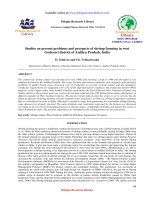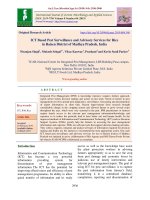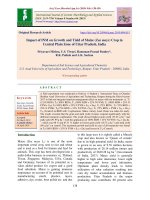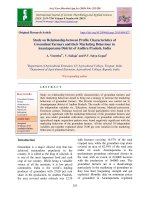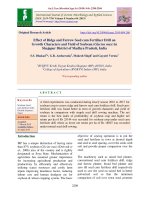Evaluation of okra hybrids in vertisols of Andhra Pradesh, India
Bạn đang xem bản rút gọn của tài liệu. Xem và tải ngay bản đầy đủ của tài liệu tại đây (147.72 KB, 5 trang )
Int.J.Curr.Microbiol.App.Sci (2018) 7(3): 3050-3054
International Journal of Current Microbiology and Applied Sciences
ISSN: 2319-7706 Volume 7 Number 03 (2018)
Journal homepage:
Original Research Article
/>
Evaluation of Okra Hybrids in Vertisols of Andhra Pradesh, India
C. Sarada*, A. Rajani, T. Vijayalakshmi, C. Venkata Ramana,
K. Sirisha and L. Naran Naidu
Horticulture Research Station, Lam Dr YSRHU, India
*Corresponding author
ABSTRACT
Keywords
Okra, Abelmoschus
esculentus L,
Growth, Yield,
YVMV incidence
Article Info
Accepted:
26 February 2018
Available Online:
10 March 2018
Okra (Abelmoschus esculentus L.), locally known as Bhendi or ladies finger, is one of the
most important vegetable crop grown in AP in all the seasons. Presently okra is grown in
an area of twenty three thousand hectares and production is estimated at about 4.39 metric
tonnes. The major problem in okra is yellow vein mosaic virus. The main area is occupied
by hybrids from private sector. Different cultivars require different climatic condition and
the performance of these entries depend on their adoptability to a particular climate and
soil conditions. Hence, the present investigation was done with an objective to evaluate the
performance of hybrids from public and private sector in Vertisols of AP during kharif
season at Horticultural Research Station, Lam. The trial was conducted with eleven entries
consisting of seven hybrids with four checks in RBD replicated thrice. Recommended
package of practices and need based plant protection measures were taken. The data was
recorded on plant height, number of fruits, days to 50% flowering, fruit length, fruit girth,
average fruit weight yield and %YVMV incidence. Among the entries, significantly
maximum plant height was recorded by BSS-428, whereas OH-597 recorded minimum
plant height. Among the hybrids under evaluation, significantly more number of fruits was
observed in HOK-152 being on par withBSS-828, AROH-631 and Kaveri -919. Among
the hybrids, the highest yield was recorded by Kaveri -555 which is significantly superior
to all the entries, followed by Kaveri – 919. The maximum yield recorded by Kaveri -555
may be attributed to 100 fruit weight, fruit length and fruit girth and it came to flowering
early. Incidence of YVMV ranged from 6.7 (BSS-828) to 55.1 (AROH-631).
Introduction
Okra is the only important vegetable crop in
Malvaceae family. The Egyptians made the
first recorded reference to okra in 1216 A.D. It
is originated in tropical Africa and was also
grown in Mediterranean region and its wild
forms are found in India. It is now grown in
all parts of the tropics and during the summer
in the warmer parts of the temperate region. It
is a semi woody, fibrous herbaceous annual
with an indeterminate growth habit. Okra is
mainly a self-pollinated crop however; insects
such as honey bees do cross-pollination
occasionally. Okra is adapted to a wide range
of soil. A well-drained fertile soil with an
adequate content of organic matter and
reserves of the major elements are generally
suitable for cultivation. However, some
cultivars are sensitive to excessive soil
3050
Int.J.Curr.Microbiol.App.Sci (2018) 7(3): 3050-3054
moisture. Others are slightly tolerant to salt.
Optimum pH ranges from 6.6 to 8.0. Most
cultivars are adapted to high temperature
throughout the growing period with little
seasonal fluctuation.
Okra is an important vegetable crop grown in
Andhra Pradesh. Presently okra is grown in an
area of twenty three thousand hectares and
production is estimated at about 4.39 metric
tones. Okra is generally cultivated throughout
the year both in kharif and summer seasons.
However, the incidence of Yellow vein
mosaic was more during summer season than
kharif. It is consumed as fresh vegetable and
also used in canning. The major problem in
okra is yellow vein mosaic virus. Most of the
farmers are cultivating the private hybrids
without knowing their performance and
suitability to the particular agro climatic zone.
Hence, the present investigation was carried
out with an objective to find out the suitability
of various okra hybrids from public and
private sector to find out their suitability and
also to study their performance with respect to
resistance to yellow vein mosaic disease in
Vertisols of AP.
Materials and Methods
The
experiment
was
conducted
at
Horticultural Research station, Lam, during
2010-11. The experiment was laid down in
Randomized Block design with eleven entries
from public and private enterprises, with three
replications. The eleven entries were Kaveri919, Kaveri- 555 from Kaveri seeds, AKOH2006-04 from Akola, OH-597, HOK-152 from
Syngenta, BSS-828 from Bejo sheetal seeds,
NOH-537 from Nirmal seeds, AROH-631
from Ankur seeds, Purbani Kranthi from
Parbhani, Arka Anamika from IIHR, Pusa
Sawani from IARI, New Delhi. The trial was
sown in the month of July. Recommended
dose of fertilizer (48:24:24) was applied ain
the form of urea, single super phosphate and
Murate of potash. Phosporus was applied as
basal dose and Nitrogen and Potassium was
applied in three splits at basal, 30 and 45 days
after sowing. After field preparation seeds
were sown in well-prepared soil in lines with a
distance of 60cm in rows and plant to plant
distance of 30 cm within the row.
Recommended package of practices and need
based plant protection measures were taken.
The data was recorded on five randomly
selected plants from each plot on plant height,
number of fruits per plant, days to 50%
flowering, fruit length, fruit girth, average
fruit weight yield and %YVMV incidence.
The mean data was analyzed statistically as
per the procedure laid by Panse and
Sukhathme (1984).
Results and Discussion
Significant differences were observed among
the hybrids in yield and yield attributing
characters.
Plant height
Significant differences were observed among
the entries with respect to plant height. Plant
height ranged from 105.0cm to 196.3cm.
Among the entries, significantly maximum
plant height was recorded by BSS-428
(196.3cm)
whereas
OH-597
recorded
minimum plant height (105.0 cm). The
variation observed in different hybrids in the
present study may be due to genetic nature of
the hybrids.
The results are in conformity with the findings
of Farook Ali khan et al., (2002). The height
of the plant can potentially affect yield as
those that are taller are usually more number
of nodes contributing for higher yield.
However, the taller plants may be prone to
lodging in wind prone areas. Keeping this in
view, pant height, which is one of the
important agronomic and most variable trait
3051
Int.J.Curr.Microbiol.App.Sci (2018) 7(3): 3050-3054
may be kept in mind during selection
programmes aimed at improving desirable
traits in okra (Akinyele and Oseikita, 2006).
Plant girth: Significant differences were
observed among the hybrids with respect to
plant girth. Among the hybrids, significantly
maximum plant girth was observed in BSS828 (9.8cm), whereas lowest stem girth was
observed in Pusa sawani (7.5cm). The
variability observed in different hybrids in
stem girth may be due to genetic makeup of
the hybrids.
Days to flowering: Significant differences
were observed among the cultivars with
respect to number of days taken to flowering.
Among the hybrids, Kaveri -555 required
significantly minimum number of days to first
flowering indicating its earliness. The
maximum number of days to first flowering
was recorded in BSS-828 (42 days) followed
by AKOH-2006-04, OH-597, and NOH-537
which were statistically on par with each
other. The difference in number of days to
flowering might be due to the genetic
variation among the cultivars because all the
cultural practices were kept uniform for all the
cultivars.
The early flowering may be attributed to the
genetic makeup of the cultivar. The result are
also in accordance with Muhammad Amzad
2001, who reported that okra cultivars differed
significantly in all the parameter including the
days taken to first flowering. It has been
demonstrated that on a general basis, early
flowering is detrimental for overall
productivity in okra as the source to sink ratio
will be potentially limited for effective
photosynthesis (Abhayogya et al., 1994).
However, earliness is preferable character in
cropping systems. Depending on the desire of
the breeder or farmer, appropriate selection
can thus be made for either early or late
maturing plants.
Number of fruits per plant: The data with
respect to number of fruits per plant showed
significant differences among the cultivars
under present study. The number of fruits per
plant varied from 13.7 in AKOH-2006-04 to
21.3 in HOK–152.Among the hybrids under
evaluation, significantly more number of fruits
was observed in HOK-152 (21.3) being on par
with BSS-828 (19.1), AROH-631 (18.9) and
Kaveri -919 (18.6).
The variation observed in the present study
with respect to number of pods per plant may
be due to genetic character of the hybrid or it
may be due to the non-adoptability of the
hybrid to the particular climate and soil
condition. The results are in conformity with
the findings of Farook Ali Khan et al., (2002),
Muhammad Amjad et al., (2001) who also
observed variability in number of pods per
plant in okra.
Fruit weight: The present data revealed
significant differences with respect to 100 fruit
weight among the cultivars. The fruit weight
ranged from 1.7 kg in AKOH-2006-04 to
2.8kg in Kaveri- 555. Among the hybrids
under evaluation, Kaveri -555 recorded
maximum 100 fruit weight (2.8kg) and it is
significantly superior to all the other entries.
Similar results of variation in pod weight was
recorded by Ashraful and Hossain (2006),
Sachan VK (2006), Farook ali Khan etal
(2002) Neeraja et al., (2002) and Srabani and
Nath (2003).
Fruit Length: Significant differences were
observed among the cultivars with respect to
fruit length. Fruit length varied from 12.15 cm
in HOK-152 to 17.57 in Kaveri- 555. Among
the cultivars, Kaveri -555 recorded maximum
fruit length (17.57cm) being on par with
Kaveri -919. The variability observed in fruit
length may be due to varietal character of the
particular hybrid under observation (Table 1).
3052
Int.J.Curr.Microbiol.App.Sci (2018) 7(3): 3050-3054
Table.1 Performance of okra hybrids for growth, yield attributes and yield
Entry name
Plant
Height
(Cm)
Plant
girth
(Cm)
Days to Number
100
Fruit
first
of
pod wt length
flowering fruits- (Kg/pl) (Cm)
Plant
40.0
18.6
2.5
16.48
Kaveri -919
162.8
9.2
AKOH2006-04
OH-597
115.3
8.8
41.0
13.7
1.70
13.07
5.73
105.0
9.0
41.0
17.1
1.80
13.77
6.42
BSS-828
NOH-537
196.3
143.0
9.8
9.4
42.3
41.7
19.1
16.0
2.07
1.90
12.75
13.03
6.52
6.35
AROH-631
146.3
9.4
38.0
18.9
1.95
13.70
6.48
Kaveri -555
145.1
9.3
31.0
17.2
2.80
17.57
7.57
HOK-152(c)
157.0
9.9
38.7
21.3
2.00
12.15
6.28
Purbani
Kranthi
Arka
Anamika
Pusa Sawani
132.1
9.0
38.0
16.8
1.98
13.05
6.13
120.3
8.6
38.7
13.5
1.82
13.40
6.84
128.9
7.5
38.7
18.5
1.87
12.38
6.18
CD
C. V %
22.65
9.41
1.11
7.16
2.01
3.03
2.61
8.83
0.44
12.72
2.59
11.01
0.67
6.11
The difference in fruit length might be due to
the differences in genetic makeup of the
cultivars and their response to prevailing
environmental conditions. Similar results of
variation if fruit length in okra genotypes was
reported by Muhammad Amzad (2001),
Saifullah
and
Rabbani
(2009)
and
Anwanobong (2015).
Fruit Girth: Significant differences were
observed among the cultivars with respect to
fruit girth also. Fruit girth varied from 6.13 in
Parbani Kranthi to 7.57 in Kaveri- 555.
Among the cultivars, Kaveri -555 recorded
significantly maximum fruit length (7.57cm).
Fruit
girth
(Cm)
6.5
Yield
%
(Q/ha Incidence
of
YVMV
57.13
23.9
(29.2)
32.49
45.5
(44.4)
56.22
29.8
(32.9)
51.42 6.7 (14.9)
47.79
43.2
(41.1)
51.34
55.1
(47.9)
76.29
10.3
(18.7)
48.03
17.6
(24.5)
54.15
51.9
(46.1)
46.55
50.6
(45.3)
36.7
17.0
(24.3)
5.4
14.96
9.43
17.28
The variability observed in fruit girth may be
due to varietal character of the particular
hybrid under observation. Similar results of
variation in pod weight were recorded by
Ashraful and Hossain (2006) and Sachan
(2006).
Yield: Among the hybrids, the highest yield
was recorded by Kaveri- 555 (76.29 q/ha)
which is significantly superior to all the
entries, followed by Kaveri -919 (57.13 q/ha).
The maximum yield recorded by Kaveri- 555
may be attributed due to 100 fruit weight (2.8
kg/pl.), fruit length (17.57cm) and fruit girth
(7.57cm) and it came to flowering early
3053
Int.J.Curr.Microbiol.App.Sci (2018) 7(3): 3050-3054
(31days). Similar results of differences in
green fruit yield of okra genotypes were
obtained by Farook Ali Khan et al., (2002),
Muhammad Amzad (2001) Neeraja et al.,
(2002) and Srabani and Nath (2003), Eshiet
and Brisibe (2015).
Incidence of YVMV – The present study
indicated that none of the hybrids were found
to be immune to YVMV incidence. Incidence
of YVMV ranged from 6.7 (Bss-828) to 55.1
(AROH- 631). The varying level of disease
severity could be attributed to the response of
entries to YVMV incidence. The climatic
conditions especially temperature and
humidity may directly influence the vector
(white fly) population (Samarjeewa and
Rathnayaka, 2004). Among the hybrids,
AROH- 631 was highly susceptible to YVMV
incidence followed by Parbani Kranthi.
Similar type of screening for incidence of
yellow vein mosaic in okra has been reported
by Phad et al., (2009) and Mahaveer
Deshmukh et al., (2011).
References
Akinyele BO, Oseikita OS (2006) Correlation and
path coefficient analyses of seed yield
attributes in okra (Abelmoschus esculentus
(L.)
Moench).
African
Journal
of
Biotechnology 5: 1330-1336
Ashraful AKM, Hossain MD (2006) Variability of
different yield contributing parameters and
yield of some okra (Abelmoschus esculentus
L) accessions. J Agric Rural Dev 4: 119-127.
Deshmukh ND, BP Jadhav, IS Halakude and JC
Rajput (2011) Identification of new resistant
sources for yellow vein mosaic virus disease
of Okra (Abelmoschus esculentus L.).
Vegetable Science 38(1): 79-81
Eshiet AJ, Brisibe EA (2015) Morphological
Characterization and Yield Traits Analysis in
Some
Selected
Varieties
of
Okra
(Abelmoschus esculentus L. Moench). Adv
Crop Sci Tech 3(5): 197. -202
Farooq Ali Khan, Jalal ud din, Abdhul Ghaffoor
and Kashif Waseem Khan (2002). Evaluation
of different cultivars of Okra (Abelmoshos
esulantus L.) under the agro –climatic
conditions of Dera Ismail Khan. Asian
Journal of plant Sciences Vol.1 No.6:663664.
Muhammad
Amjad,
Muhammad
Sultan,
Muhammad Akbar Anjum, Chaudhry
Muhammad Ayyub and Muhammad mushtaq
2001.
Comparative
Study
on
the
Performance of Some Exotic Okra Cultivars.
International Journal of Agriculture &
Biology Vol 3(4):423–425.
Neeraja, G., Gautham, B. and Reddy, I.P. (2002).
Comparative yield trail in okra (Abelmoschus
esculentus (L.) Moench) hybrids under
southern telanga zone of Andhra Pradesh.
Orissa J. Hort., 30(2): 20-22.
Phad GN, AB Suryawanshi, DA. Agale and SR.
Chavan (2009). Performance of New Hybrids
of Okra [Abelmoschus esculentus (L.)
Moench] For Yield, Yellow Vein Mosaic
Virus and Fruit Borer. International Journal
of Plant Protection, Vol. 2 No. 1: 140-141
Sachan VK (2006) Performance of okra
(Abelmoschus esculentus L.) varieties in midhills of Sikkim Orissa. Journal of
Horticulture 34: 131-132.
Saifullah M, Rabbani MG (2009) Evaluation and
characterization of okra (Abelmoschus
esculentus L. Moench.) genotypes. SAARC J
Agric 7: 91-98.
Srabani, Debnath and Nath, P.S. (2003).
Performance of okra varieties in relation to
yield and tolerance to YVMV. Ann.
Pl.Protec. Sci., 11(2): 400-401.
How to cite this article:
Sarada, C., A. Rajani, T. Vijayalakshmi, C. Venkata Ramana, K. Sirisha and Naran Naidu, L.
2018. Evaluation of Okra Hybrids in Vertisols of Andhra Pradesh, India.
Int.J.Curr.Microbiol.App.Sci. 7(03): 3050-3054. doi: />
3054

